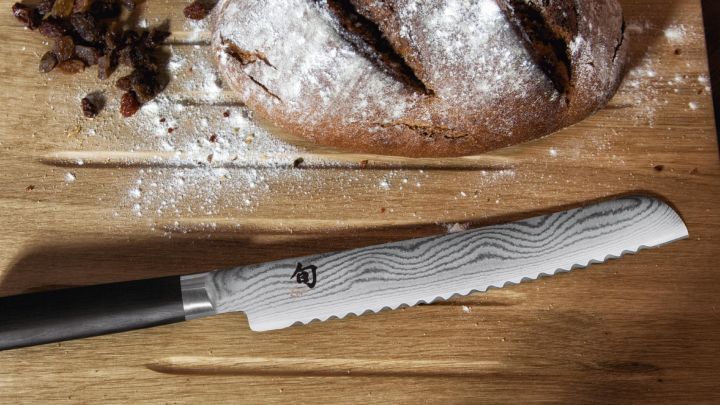FREE SHIPPING FOR ORDERS OVER $199
60 DAYS RETURN POLICY
5% OFF FOR NEWSLETTER-SIGN UP
Knife Guide

A good knife, like this Kai Shun Classic does wonders for the joy of cooking!
OUR GUIDE TO CHOOSING THE RIGHT KNIFE
Choosing the right knife for the a specific job should not be underestimated. The cooking experience can be a real joy with knives that are specifically adapted for their task. It is therefore a great idea to have a knife for every function you perform in the kitchen. Maybe a chef's knife and a bread knife cover all your needs? Or if you are a real master chef who also likes to prepare your fish and meat from scratch then a fillet knife may also serve a purpose. Join us in our guide of the most common knives.
1. The chef's knife: the kitchen's most common knife and a fantastic all-arounder! The chef's knife is more or less a must have in the kitchen as it can be used for several different ingredients. The knife has a wide blade and a handle that sits higher up so that you do not hit the cutting board with your fingers as you chop.

Kai Shun Nagare all purpose knife from Kai has a hardness of 61 HRC and is perfect for both the master chef and the amateur chef.
The Norden Chef's Knife from Fiskars with an elegant wooden handle.
2. The fillet knife: if you want to fillet fish like a pro, a sharp fillet knife is a great investment in the kitchen! This knife is characterised by its sharp, narrow blade so that you can easily fillet fish and remove the skin without losing too much of the meat. Thanks to the length of the blade, you can work with long sweeping movements.
The Norden fillet knife from Fiskars is perfect for filleting fish thanks to its narrow and long blade.
3. The bread knife: the toothed bread knife easily cuts through crusty bread with ease. This type of knife is designed to get through hard crust of a freshly cooked bread loaf while at the same time preserve the consistency of soft inner. Top tip: a bread knife works just as well for a to cut a slice of bread in the morning as a head of salad for dinner.

The bread knife from the Norden series also sports an elegant wooden handle and cuts through crusty bread with ease.

The perfect slice for your morning bread with the Kai Wasabi bread knife.
The Norden vegetable knife from Fiskars works perfectly as a peeling knife.
4. The peeling knife: the peeling knife is a perfect universal knife as it works for various purposes such as peeling root vegetables or fruit. The knife has a straight and pointed blade of about 8-12 cm, which makes it the kitchen's smallest knife. The flexible size of the peeling knife is adapted so that you can keep both the knife and whatever you are peeling in the air for a smooth peel.
A peeling knife should be easy to hold in your hand, just like the Norr peeling knife from Fiskars.

The high, wide blade on the vegetable knife allows you to chop easily and quickly - here you see the Nordic Kitchen vegetable knife from Eva Solo.

Protect your knives in style with the Signaturee Book Oak knife block from Robert Welch.
THE CHECKLIST
- Store your knives safely - preferably on a knife strip or in a knife block for more protection for the blade. Proper storage preserves the sharpness of the knife better than if it is in the kitchen drawer.
- Use a cutting board in wood or plastic as these are gentler on the edge of the blade than hard surfaces such as marble.
- Use the back of the knife, not the edge, when you scrape off your chopped ingredients. Do not saw with the knife, back and forth and never cut into frozen ingredients or bones.
- Never wash your knife in the dishwasher as it dulls the blade and the properties of the metal may be affected. Use lukewarm water and detergent instead – a more thorough cleaning should not be required.
- Does your knife have superficial rust stains? It can be easily removed with a little metal polish or polishing rubber.
- Finally, sharpen your knives regularly for maximum longevity.

The Fiskars titanium Chef's knife is a sharp, precise tool in the kitchen.
HARDNESS OF THE BLADE
In addition to the fact that there are different kitchen knives for different jobs, the degree of hardness in the steel also affects the function of the knife. The hardness of a knife blade is measured in the HRC (Rockwell) scale. Soft blades with a hardness of 54 HRC, for example, are easy to sharpen and most chef's knives have a hardness between 54–64 HRC, which means that the blades are durable but the sharpness can weaken over time. The standard recommendation for a kitchen is to have four knives - but what they are and what hardness they have, you can decide based on your needs and what properties you are looking for in a knife.
Text: Arijana Kapic
